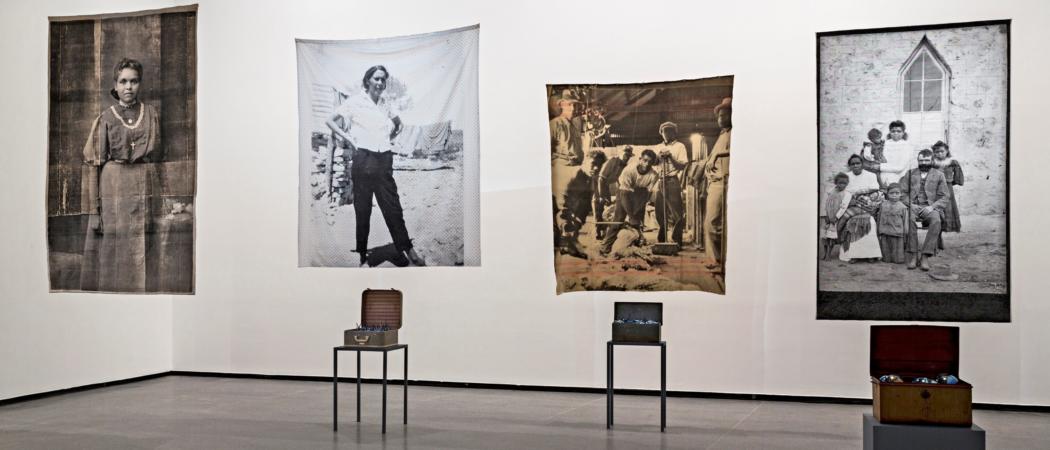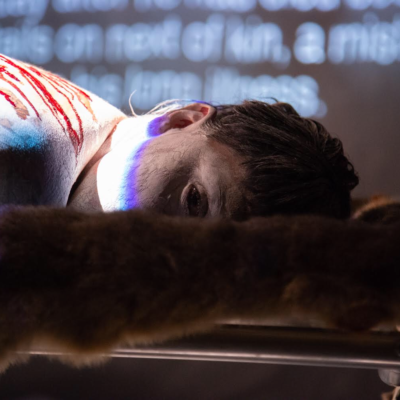The Museum of Contemporary Art Australia (MCA) and Tate have today announced the acquisition of six artworks by five artists as part of the International Joint Acquisition Program for contemporary Australian art.
Since its inception the program has made possible the acquisition of 35 artworks by 24 artists for the Collections of Tate and MCA. This ground-breaking acquisition program which has brought the work of Australian artists to the attention of a global public was made possible through a $2.75 million corporate gift from the Qantas Foundation in 2015.
The most recent acquisitions include the sculptural work Untitled (Interiors) (2008) by Simryn Gill (Sydney and Malaysia), canvas painted in natural earth pigments Garnkiny (2013) by senior Gija artist Mabel Juli (East Kimberley, Western Australia), bark painting, Baratjala (2020) by senior Yolŋu artist Noŋgirrŋa Marawili (East Arnhem Land, Northern Territory), installation, Remember Royalty (2018) by Kokatha and Nukunu artist Yhonnie Scarce (Melbourne) and two abstract paintings massacre inlet (1994) and memory scar, grevillea, mangrove pod (& net) (2020) by Waanyi artist Judy Watson (Queensland).
The jointly acquired artworks by Mabel Juli, Noŋgirrŋa Marawili, Judy Watson and Yhonnie Scarce, will soon go on display for the first time at Tate Modern in London as part of their expanded rehang of the acclaimed collection exhibition A Year in Art: Australia 1992. Extended to 14 May 2023, this presentation explores Aboriginal and Torres Strait Islander peoples’ relationship to Country as well as colonisation’s ongoing impact on issues of representation, social injustice and climate emergency. Simryn Gill’s series of sculptures Untitled (Interiors) (2008) are currently on display at the MCA in MCA Collection: Perspectives on place, an exhibition bringing together artworks that respond to the the social and physical aspects of place.
Museum of Contemporary Art Australia Director, Suzanne Cotter, said: “The MCA and Tate
International Joint Acquisition partnership continues to play a significant role in promoting contemporary Australian art and Australian artists to international audiences. We are delighted visitors to Tate Modern can see the works of many Aboriginal and Torres Strait Islander artists and learn about their culture and personal connections to land and history. We look forward to bringing these works back to the MCA for visitors to experience in the future.”
Tate Modern Director, Frances Morris, said: “Thanks to the generosity of the Qantas Foundation, this valuable collaboration with the MCA has enabled both collections to represent Australian art at its best, deepening our understanding of international contemporary art and allowing us to tell new transnational art histories. We are thrilled to be welcoming many of the artists into Tate’s collection for the first time and look forward to sharing these significant works with our visitors.”
About the artworks and artists:
Simryn Gill
Born 1959, Singapore. Lives and works Sydney, New South Wales and Port Dickson, Malaysia.
The work of Simryn Gill considers questions of place and history and how they might intersect
with personal and collective experience. Using objects, language and photographs, her work
conveys a deep interest in material culture and in the ways that meaning can transform and
translate into different contexts. Each of the sculptures in Simryn Gill’s series Untitled (Interiors)
(2008) was cast from a crack in the earth that formed during a crippling drought in southern
Australia. Between 2001 and 2009, Gill travelled to regional New South Wales visiting properties
near Nyngan and Lake George that were dramatically affected by the prolonged dry spell.
At each location, she made imprints of fissures that had emerged in dam and creek beds by
pouring silicon into the gaps and waiting for it to cure. Once hardened, the silicon registered
these negative spaces as positive forms. Gill then reproduced these forms as bronze casts
transforming these fugitive voids into lasting documents.
Mabel Juli
Born 1932, Moola Bulla Station, East Kimberley, Western Australia. Lives and works Warmun, East Kimberley, Western Australia. Gija people.
Mabel Juli is a senior Gija artist whose work is informed by the detailed cultural stories that have
been passed down to her from family. Garnkiny (2013) is a large square canvas painted in natural
earth pigments. At the centre of the work, floating on a dense textured black charcoal ground, is
a crescent moon topped by a four-pointed star that has been painted in warm yellow ochre and
outlined in dots of white clay. Garnkiny (moon) and Wardel (star) are signature motifs of Juli’s
paintings that tell an important Gija Ngarranggarni story of which she is custodian. The work
exemplifies the enduring significance of the Garnkiny story within Juli’s practice, as well as her
highly distinctive, distilled aesthetic.
Noŋgirrŋa Marawili
Born circa 1938, Bäniyala, Arnhem Land, Northern Territory. Lives and works Yirrkala, Northern Territory. Madarrpa Galpu peoples.
Working across painting, printmaking and sculpture, Noŋgirrŋa Marawili is a senior Yolŋu artist
working out of Yirrkala in northeast Arnhem Land. Marawili’s work draws on Yolŋu culture alongside aspects of her own personal history and experience. Baratjala (2020) depicts one of Marawili’s enduring subjects: a story connected to an important coastal site on her Madarrpa clan estate, where crashing waves and lightning meet the resolute mass of enormous, partially submerged boulders. The work demonstrates the significant relationship between land, sea and sky in Yolŋu life. The minimal and deliberate nature of the composition differentiates this work from others by the artist with a more spontaneous sensibility.
Yhonnie Scarce
Born 1973, Woomera, South Australia. Lives and works Melbourne, Victoria.
Kokatha Nukunu Mirring peoples.
Yhonnie Scarce’s practice explores the legacies of historical events and government policies
in Australia, foregrounding an Indigenous perspective and connection to Country. Remember
Royalty (2018) is a large installation comprising four suspended portraits and three accompanying
sculptures, arranged to evoke a kind of shrine. The black and white photographic images are drawn from family archives and depict Scarce’s great-great grandmother Melba c.1917; her great-great grandfather William c.1920 (Melba’s husband); her grandmother Fanny c.1950; and other family members in a group portrait taken at the Koonibba Mission c.1911, where they lived under duress. Each image has been radically enlarged and screen-printed onto a sheet or blanket of roughly the same vintage as the original photographs. Scarce has paired the portraits with offerings in the form of hand-blown glass objects and found items. The work is unique within her output for the way it synthesises sculptural, photographic and textile elements. It is further distinguished by an overtly personal narrative and the use of photographic images from Scarce’s family archive.
Judy Watson
Born 1959, Mundubbera, Queensland. Lives and works Brisbane, Queensland.
Waanyi people.
Drawing on her Aboriginal heritage, Judy Watson works across painting, printmaking and sculpture to explore themes relating to her matrilineal family from Waanyi country in Northwest
Queensland. Concerned with collective memory, Watson’s work often uses archival documents
to unveil institutionalised discrimination against Aboriginal people. The title of the large canvas
work massacre inlet (1994) refers to a river inlet off the Gulf of Carpentaria in the northwest of
Queensland, which is reported to be the site of a massacre of Ngyanga people in the late nineteenth century. The abstract composition suggests a skeletal form or the tributaries of a river system – invoking both a blood-stained landscape and the entanglement of body and land in Aboriginal culture. memory scar, grevillea, mangrove pod (& net) (2020) is one of Watson’s most significant recent works. Whereas much of her practice engages with collections and archives, this painting is distinguished by its origins in the artist’s lived experience. Visually, it exemplifies Watson’s unique approach to building layered compositions on unstretched canvas by combining washes of pigment, transposed motifs and other forms of mark making – in this case intricately stitched line work that refers to scarring as a sign of trauma, but also of repair. Watson made this painting during the first wave of the COVID-19 pandemic. The organic materials were gathered from her garden and on walks. The red lines, meanwhile, are based on a graph that was circulating in news media showingthe effect of Australia’s economic recession on household savings.
About the Museum of Contemporary Art Australia (MCA)
The Museum of Contemporary Art Australia (MCA) is Australia’s leading contemporary art museum dedicated to exhibiting, collecting, and interpreting the work of living artists. The MCA is located on one of the world’s most spectacular sites on the edge of Sydney Harbour at Tallawoladah, on the traditional lands of the Gadigal people of the Eora nation. The Museum presents exhibitions and learning programs that engage a broad and diverse public. The MCA Collection contains over 4,500 works with a sustained commitment to works by Aboriginal and Torres Strait Islander artists.
About Tate
Tate’s mission is to increase the public’s understanding and enjoyment of British art and international modern and contemporary art. It stages exhibitions, displays and events across fourmuseums: Tate Britain, Tate Modern, Tate Liverpool and Tate St Ives. These are part of a wider network of partner galleries – the Plus Tate network – which champion the visual arts throughout the UK. Tate also manages a growing national collection of over 70,000 works of art, from paintings, drawings, sculptures and prints to photographs, films, installations and performances. These are acquired and cared for on behalf of the public and shown in venues throughout the UK and across
the world.

